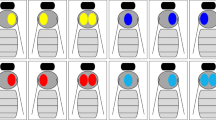Abstract
We artificially inseminated queens of Apis mellifera scutellata and A. m. capensis with equal numbers of drones of both subspecies to determine the effects of sperm genotype on rates of sperm utilization. Contrary to a previous study we did not find a consistent overrepresentation of workers sired by A. m. scutellata males in the first four months after insemination. Interestingly, our study does suggest that there is a significant interaction between drone and queen genotype in both subspecies, with queens of each subspecies producing more workers sired by drones of the same subspecies.
Similar content being viewed by others
References
Aljanabi S.M., Martinez, I. (1997) Universal and rapid salt-extraction of high quality genomic DNA for PCR-based techniques, Nucleic Acids Res. 25, 4692–4693.
Allsopp M. (1992) The capensis calamity, S. Afr. Bee J. 64, 52–57.
Anderson R.H. (1980) Cape honey-bee sanctuaries, S. Afr. Bee J. 52, 5–9.
Baer B. (2005) Sexual selection in Apis bees, Apidologie 36, 187–200.
Beekman M., Allsopp M.H., Wossler T.C., Oldroyd B.P. (2008) Factors affecting the dynamics of the honey bee (Apis mellifera) hybrid zone in South Africa, Heredity 100, 13–18.
Buys B. (1990) Features of basic reproduction in drones and queens of the Cape honeybee Apis mellifera capensis, in: Anderson R.H., Buys B. (Eds.), Proceedings of the International Beekeepers’ Symposium: Bees and beekeeping in Southern Africa, Posa & WPBA, Cape Town, pp. 106–109.
DeGrandi-Hoffman G., Tarpy D.R., Schneider S.S. (2003) Patriline composition of worker populations in honeybee (Apis mellifera) colonies headed by queens inseminated with semen from African and European drones, Apidologie 34, 111–120.
Franck P., Garnery L., Loiseau A., Oldroyd B.P., Hepburn H.R., Solignac M., Cornuet J.-M. (2001) Genetic diversity of the honeybee in Africa: microsatellite and mitochondrial data, Heredity 86, 420–430.
Hepburn H.R., Crewe, R.M. (1991) Portrait of the Cape honeybee, Apis mellifera capensis, Apidologie 22, 567–580.
Hepburn H.R., Radloff S.E. (1998) Honeybees of Africa, Springer, Berlin.
Koeniger G., Koeniger N., Pechhacker H., Ruttner F., Berg S. (1989) Assortative mating in a mixed population of European honeybees, Apis mellifera ligustica and Apis mellifera carnica, Insectes Soc. 36, 129–138.
Koeniger G., Koeniger N., Tingek S., Phiancharoen M. (2005) Variance in spermatozoa number among Apis dorsata drones and among Apis mellifera drones, Apidologie 36, 279–284.
Laidlaw H.H. (1978) Instrumental Insemination of Honey Bee Queens, Dadant & Sons, Inc., Hamilton, Illinois.
Martin S.J., Wossler T.C., Kryger P. (2002) Usurpation of African Apis mellifera scutellata colonies by parasitic Apis mellifera capensis workers, Apidologie 33, 215–232.
Onions G.W. (1912) South African “Fertile” worker bees, S. Afr. Bee J. 1, 720–728.
Rinderer T.E., Collins A.M., Pesante D., Daniel R., Lancaster V., Baxter J. (1985) A comparison of Africanized and European drones: eights, mucuc gland and seminal vesicle weights, and counts of spermatozoa, Apidologie 16, 407–412.
Solignac M., Vautrin D., Loiseau A., Mougel F., Baudry E., Estoup A., Garnery L., Haberl M., Cornuet J.-M. (2003) Five hundred and fifty microsatellite markers for the study of the honeybee (Apis mellifera L.) genome, Mol. Ecol. Notes 3, 307–311.
Spivak M., Breed M.D., Fletcher D.J.C. (1991) The African Honey Bee, Westview Press, Boulder, Colorado.
Verma S., Ruttner, F. (1983) Cytological analysis of the thelytokous parthenogenesis in the Cape honeybee (Apis mellifera capensis Escholtz), Apidologie 14, 41–57.
Author information
Authors and Affiliations
Corresponding author
Additional information
Manuscript editor: Marina Meixner
Rights and permissions
About this article
Cite this article
Holmes, M.J., Allsopp, M.H., Noach-Pienaar, LA. et al. Sperm utilization in honeybees (Apis mellifera scutellata and A. m. capensis) in South Africa. Apidologie 42, 23–28 (2011). https://doi.org/10.1051/apido/2010031
Received:
Revised:
Accepted:
Published:
Issue Date:
DOI: https://doi.org/10.1051/apido/2010031




